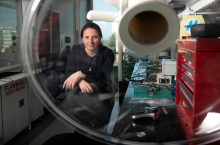MSE 298 Seminar: Understanding Performance and Durability of Amorphous and Crystalline Irox Catalysts for Proton Exchange Membrane Water Electrolysis

Abstract: To meet cost targets for GW-scale deployment of proton exchange membrane water electrolyzers (PEMWEs), iridium (Ir) loading needs to be reduced by about factor of ten to below 0.1 mg/cm . However, catalyst layer integrity for low IrOx catalyst loadings can suffer from poor in-plane electric conductivity and overall poor particle-to-particle connectivity. To study low catalyst loadings a rigorous methodology is needed, where catalyst layer inhomogeneities can be identified before extensive activity and durability studies. Here, we present a framework for testing low loading IrOx catalysts within membrane electrode assembly (MEA), where loading study was conducted using two Ishifuku catalysts having different structures: amorphous and crystalline. By varying catalyst loading, electrochemical descriptors were obtained such as mass specific activity, exchange current density, specific surface charge and others. The change in voltage in kinetic region between various catalyst loadings corresponded to Tafel slope, indicating that the catalyst surface area reduction was the major reason for the activity loss at lower loadings. We performed voltage breakdown analysis for polarization curves, as well as pseudo-capacitance breakdown for cyclic voltammetry using equivalent circuit models. The amorphous catalyst showed higher activity across all the loadings and current densities, lower Tafel slope, higher surface charge and about 5 times higher mass activity and exchange current density compared to crystalline catalyst. The physical characterization of the two catalysts through x-ray photoemission spectroscopy (XPS), Raman spectroscopy, BET analysis, x-ray diffraction, electron imaging reveals the morphological and surface characteristics for each catalyst. Amorphous Ishifuku catalyst is confirmed to have amorphous structure with high population of μ1 oxygen species on the surface that are believed to be responsible for high oxygen evolution reaction (OER) rates. Overall, here we show that loading study is a necessary first step for catalyst layer characterization with low catalyst loadings. Furthermore, we extend the study for 750 hours durability operation and evaluate crystalline and amorphous catalysts at the end of life. Amorphous catalyst structure shows transformation into crystalline, where exact mechanisms for such transformation are not yet well understood.
Bio: Iryna Zenyuk is a professor of chemical and biomolecular engineering and director of the National Fuel Cell Research Center, UC Irvine. She holds a bachelor's degree (2008) in mechanical engineering from the New York University Tandon School of Engineering. She continued her studies at Carnegie Mellon University, where she earned a master's degree (2011) and doctorate (2013) in mechanical engineering. Zenyuk did her postdoctoral fellowship at Lawrence Berkeley National Laboratory in Electrochemical Technologies Group. She is a recipient of the NSF CAREER award (2017), Interpore Society Fraunhofer Award for Young Researchers (2017), Research Corporation for Science Advancement, Scialog Fellow in Advanced Energy Storage (2017-2019), Electrochemical Society (ECS) Toyota Young Investigator Award (2018), UCI Samueli School of Engineering Early Career Faculty Excellence in Research Award (2019), ECS Energy Technology Division Srinivasan Young Investigator Award (2021), UCI Beal Applied Innovations Early Career Innovator of the Year (2021) and UCI Samueli School of Engineering Mid Career Faculty Excellence in Research Award (2022). Zenyuk has published over 100 journal publications and delivered more than 100 invited presentations on topics of energy conversion and storage. Twitter handle: @muziolog Webpage: https://faculty.sites.uci.edu/zenyuklab/
Share
Related Content
| Attachment | Size |
|---|---|
| 1.25 MB |
Upcoming Events
-
MSE 298 Seminar: Electrocatalysis as Enabling Technology for Decarbonization
-
CEE Ph.D. Defense Announcement: Modeling the Spatiotemporal Heterogeneities of Electric Vehicle Adoption in the United States through Sentiment-Mediated Mechanisms - A Large Language Model-Assisted Data-Fusion Framework
-
EECS Seminar: Random Thoughts After More Than 60 years in the Trenches
-
MAE 298 Seminar: Machine Learning Acceleration of Turbulent Combustion and Nonequilibrium Flow Predictions
-
CBE 298: Green Steel: Design, Supply Chain, H2 Storage and Dispatch Strategies
